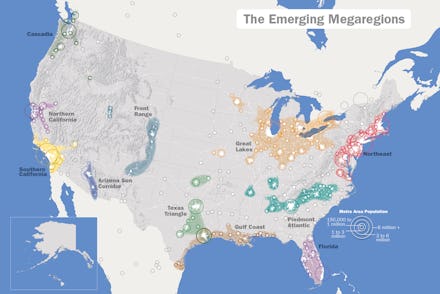Forget State Lines — This Map Shows You How America is Really Divided

This map from the Regional Plan Association, an urban research institute in New York, shows how the country is really organized — and it's not primarily around individual cities.
Instead, their America 2050 project proposes that we begin to view the country's urban areas not as discrete metropolitan areas but as interconnected "megaregions." Megaregions are areas where large cities and the spaces in between share "interlocking economic systems, shared natural resources and ecosystems, and common transportation systems."
They identify 11 in the U.S. — Cascadia, Northern and Southern California, the Arizona Sun Corridor, the Front Range, the Texas Triangle, the Gulf Coast, the Great Lakes, the Northeast, Piedmont Atlantic, and Florida (it's kind of dangling off on its own there, anyhow).
In other words, these are the areas in which residents and policymakers are the most likely to have shared common interests and policy goals and would benefit most from co-operation with each other. It's especially important, because as the Regional Plan Association notes, "Our competitors in Asia and Europe are creating Global Integration Zones by linking specialized economic functions across vast geographic areas and national boundaries with high-speed rail and separated goods movement systems."
By concentrating investment in these regions and linking them with improved infrastructure, such megaregions enjoy competitive advantages such as efficiency, time savings, and mobility.
The U.S., however, has long focused on individual metro areas and the result has been a "limited capacity" to move goods quickly — this is a major liability threatening long-term economic goals. And while U.S. commuters are opting to drive less, public transportation isn't even close to commuters' needs.
The Regional Plan Association proposes aggressive efforts to promote new construction, and finds that even existing lines are in desperate need of large-scale repairs or updates to improve service. In particular, they say the emerging megaregions need transportation modes that can work at distances 200-500 miles across, such as high-speed rail.
The agglomerations largely make sense. If you live in NYC, you're far more likely to visit or have business interests in D.C. rather than Southern California, and vice versa. And the large regions they identify could definitely benefit from enhanced intercity co-operation and the development of new transportation and infrastructural modes.
Where does your city appear, and do you agree with your classification? Weigh in in the comments below.